Exploring the attire of pioneer women unveils a fascinating intersection of practicality, modesty, and enduring style. While popular imagination might conjure images of simple, drab garments, the reality of Pioneer Woman Clothes was a testament to resourcefulness and adaptation. Moving westward from established Eastern cities between 1850 and 1890, these women faced unique challenges that profoundly shaped their wardrobes. This article delves into the essential elements of pioneer woman clothing, revealing how they skillfully blended necessity with a desire for decorum and even a touch of fashion in the rugged frontier environment.
Understanding the Frontier Context
To truly appreciate pioneer woman clothes, it’s crucial to define the “frontier” of this era. For our exploration, we’ll focus on the regions west of Missouri and Arkansas, spanning roughly 1850 to 1890. This period saw significant westward expansion, with homesteaders and settlement communities taking root in diverse landscapes. The clothing discussed primarily reflects the wardrobes of white settlers migrating from the East to carve out new lives.
It’s important to note that unlike the status-driven fashion of Eastern cities, frontier clothing was largely dictated by practicality and the shared experience of building a life in the unknown. Functionality and durability took precedence, yet these women did not entirely abandon the fashion sensibilities of their time.
The Foundation: Undergarments
Surprisingly, the underclothes worn by pioneer women were not drastically different from those in Eastern cities. Hygiene and modesty remained paramount, and the foundational garments reflected this.
The chemise, a lightweight cotton slip, was the essential first layer. Worn directly against the skin, its primary purpose was hygiene, absorbing perspiration and protecting outer garments. Chemises were made of easily washable cotton and were frequently laundered.
Next came pantalets, loose, knee-length drawers made from flannel or cotton. These served primarily for modesty, especially crucial with the full skirts of the era. It’s worth noting that tailored “panties” as we know them were not yet common.
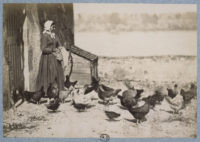 Woman in chemise and pantalets
Woman in chemise and pantalets
Perhaps contrary to assumptions of frontier hardship leading to relaxed standards, the corset was a common undergarment for pioneer women. Many women venturing west were driven by aspirations for a better future, whether economic or religious. They considered themselves “proper” and maintained the social norms they brought from the East, including wearing corsets. While some women might loosen or omit corsets for strenuous housework, it was generally considered a fundamental part of a woman’s attire and was worn whenever possible.
Over the corset, petticoats were layered. Pioneer women often owned multiple petticoats of varying materials and fullness. The number and type of petticoats worn depended on the formality of the occasion and the weather. Petticoats added warmth, shape to skirts, and another layer of modesty.
Stockings were indispensable when leaving the house or receiving guests. Typically made of cotton or wool, they were held up by garters or tucked into pantalets. The latter option, while perhaps less comfortable, was a practical solution in a time before elasticized stocking tops.
Fabrics of the Frontier: Practicality and Availability
Calico reigned supreme as the fabric of choice for pioneer clothing. Often mistakenly associated solely with floral prints, calico was actually a type of plain-woven, unprocessed cotton fabric. Slightly lighter than modern canvas, it was durable, breathable, and easy to clean – ideal for the demands of frontier life. General stores offered calico in various dyed colors, and resourceful women also dyed fabric themselves using store-bought or natural dyes derived from plants like leaves, bark, berries, and fruits.
While calico dominated daily wear, cotton and silk fabrics were still treasured for “Sunday best” and more formal dresses. Pioneer women often brought a few finer garments from their former homes for special occasions.
Fabric availability depended heavily on proximity to general stores. While stores stocked fabrics, access was not always consistent across the vast frontier. In more isolated areas, families might resort to homespun fabrics, a craft in itself, but store-bought options were preferred when accessible.
Daily Wear: Adapting Fashion to Frontier Life
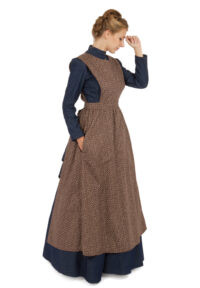 Alt text: Pioneer woman’s calico apron, a practical and essential accessory for daily chores and frontier living, showcasing the durable and functional fabric choice.
Alt text: Pioneer woman’s calico apron, a practical and essential accessory for daily chores and frontier living, showcasing the durable and functional fabric choice.
Despite the shift in environment, the general dress styles of the Victorian era – fitted bodices and full skirts – carried over into pioneer woman clothes. However, practical modifications were essential for the rigors of frontier living.
Skirt hems were raised by about three inches for everyday dresses. This shorter length allowed for greater ease of movement while performing chores and navigating uneven terrain. Some women also added weights to skirt hems to prevent them from blowing up in the wind, a practical consideration on the open plains.
Bodices remained fitted, reflecting the fashionable silhouette of the time, but sleeves were typically long and loose, extending to the wrists, and paired with high collars. These features provided crucial protection from the sun and elements during outdoor work.
Aprons were indispensable for daily wear. Made from sturdy calico or linen, aprons protected dresses from dirt and wear during cooking, cleaning, gardening, and other chores. They were a practical and versatile garment, often featuring pockets for carrying tools or gathered items.
“Wash dresses” emerged as a practical garment. These were simple, two-piece dresses made from easily washable white cotton with printed patterns. Popularized in the late 1860s, they were available in stores and also made by seamstresses. Their easy care made them suitable for women of all social classes in the frontier environment where laundry was a demanding task.
Sunday Best: Maintaining Social Graces
 Alt text: Pioneer couple dressed in their Sunday best, showcasing the influence of Victorian fashion in frontier communities, with the woman in a full skirted dress and the man in formal attire.
Alt text: Pioneer couple dressed in their Sunday best, showcasing the influence of Victorian fashion in frontier communities, with the woman in a full skirted dress and the man in formal attire.
Even in remote settlements, communities often formed around churches. Sunday church services were important social events, and pioneer women took care to present themselves respectfully. While accounts exist of extreme poverty leading some to attend barefoot, the more common practice was to reserve specific outfits for Sundays.
Sunday best dresses mirrored current fashions in Eastern cities more closely than everyday wear. Full skirts, worn over petticoats and corsets, remained the foundation. Sleeve styles reflected prevailing trends, such as puffed bell, leg-o-mutton, or pagoda sleeves. Skirt styles also followed fashion evolutions, with crinolines, hoops, or bustles appearing as they became fashionable.
Color choices for Sunday dresses followed conventions of the time. Younger women and newlyweds favored lighter colors, transitioning to darker hues as they matured.
Sunday attire was completed with the most fashionable hats available, along with kid gloves and low-heeled boots. These details demonstrated a continued connection to broader fashion trends and a desire to maintain social graces even on the frontier.
Dressing for Social Occasions: Community and Celebration
Beyond church, frontier communities found occasions for social gatherings such as dances, holiday celebrations, and picnics. These events provided opportunities for women to showcase a different facet of their wardrobes.
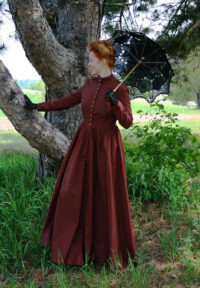 Alt text: Pioneer woman in a Victorian-style cotton dress, suitable for church or social gatherings, highlighting the enduring influence of Victorian aesthetics in pioneer woman clothing.
Alt text: Pioneer woman in a Victorian-style cotton dress, suitable for church or social gatherings, highlighting the enduring influence of Victorian aesthetics in pioneer woman clothing.
For these social events, women would ideally have a separate dress, distinct from their daily and Sunday wear. These dresses were often highly valued and represented a connection to fashion and social life beyond the necessities of frontier living.
Godey’s Lady’s Book, a popular women’s magazine of the era, played a significant role in shaping frontier fashion aspirations. Magazines were circulated and eagerly studied for dress patterns and style inspiration. Women would try to recreate the latest fashions depicted in these publications, adapting them to available materials and their own sewing skills.
However, fabric availability and dress ownership varied greatly. In more isolated areas, women might not have had a dedicated “social” dress. In such cases, their best dress, likely their Sunday dress, would be embellished with accessories to elevate it for dances or parties. Hand-crocheted collars, shawls, and other accessories became crucial for adapting and personalizing a limited wardrobe.
Accessories: The Finishing Touches of Pioneer Style
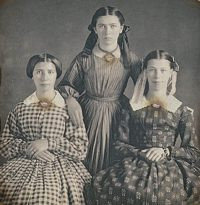 Alt text: Pioneer girls accessorizing with hats and shawls, demonstrating the importance of accessories in completing and personalizing pioneer woman clothing ensembles.
Alt text: Pioneer girls accessorizing with hats and shawls, demonstrating the importance of accessories in completing and personalizing pioneer woman clothing ensembles.
Accessories were far from afterthoughts in pioneer woman clothes; they were essential for adding polish, personality, and practicality to frontier wardrobes. Despite the emphasis on functionality, pioneer women clearly valued these finishing touches.
Key accessories for pioneer women included:
- Aprons: Beyond daily wear, finer aprons in decorative fabrics or with embellishments could dress up an outfit.
- Boots: Practical and durable footwear was essential. Boots provided ankle support and protection from the elements.
- Brooches and Lockets: Jewelry, even simple pieces, added a personal touch and a hint of elegance.
- Earrings: Another form of personal adornment, earrings were a common accessory.
- Precious Stones and Metals: While perhaps less common in poorer communities, those who could afford them incorporated precious materials into their jewelry.
- Hair Adornments: Ribbons, combs, and other hair accessories added style and kept hair neatly arranged.
- Hats and Bonnets: Hats were crucial for sun protection and were also a key fashion accessory, ranging from simple bonnets for daily wear to more elaborate hats for special occasions.
- Collars and Cuffs: Detachable collars and cuffs, often crocheted or lace-trimmed, allowed for customization and freshening up dresses.
- Gloves: Gloves were worn for warmth and formality, especially for church and social events.
- Undersleeves: Detachable undersleeves added layers and could be changed to vary the look of a bodice.
- Parasols: Parasols provided essential sun protection, especially in sunny frontier regions, and were also a stylish accessory.
- Fans: Fans offered relief from heat and were a fashionable accessory for social occasions.
- Handbags or Reticules: Small bags were used to carry personal items.
- Shawls: Shawls provided warmth and could add color and texture to an outfit.
Legacy of Pioneer Woman Clothes
The clothing of pioneer women offers a compelling glimpse into a unique era of American history. It reveals how women adapted prevailing fashion norms to the demands of frontier life, prioritizing practicality and durability without sacrificing all sense of style and personal expression. Their resourcefulness, adaptability, and enduring spirit are reflected in the garments they wore.
The enduring fascination with “prairie style” and “western wear” in contemporary fashion speaks to the lasting appeal of pioneer aesthetics. By understanding the historical context and practical considerations that shaped pioneer woman clothes, we gain a richer appreciation for their lives and the legacy they left behind.
Create Your Pioneer Look:
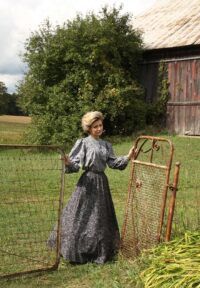 Woman in pioneer clothing standing in a field wearing a long-sleeved blue top and long blue skirt.
Woman in pioneer clothing standing in a field wearing a long-sleeved blue top and long blue skirt.
Pioneer Calico Blouse and Skirt
Browse our entire pioneer clothing collection
Pioneer Calico Blouse and Skirt
Harper Victorian Pioneer Dress
Pioneer Blouse, Apron and Skirt
